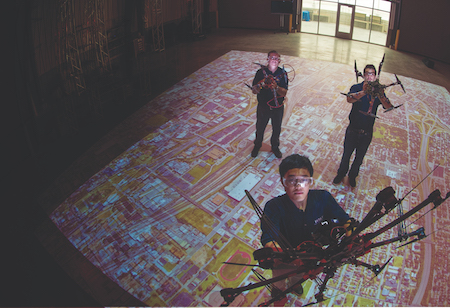By Dan Raley
At the Collaborative Autonomous Systems Laboratory, in St. Charles, Mo., flight takes place indoors. The lab represents the latest example of the Boeing company’s strategy to join smart unmanned systems with people seeking innovative ways to use them. Boeing will test and improve what others build, pushing to become the leader in a rapidly evolving autonomous industry, said Nancy Pendleton, Boeing’s System Technology director.
In the middle of the 8,100-square-foot (750-square-meter) building is a high bay outfitted with an infrared motion-tracking system and a dozen overhead projectors. This enables Boeing engineers to cover the floor with virtual mapping and put unmanned aircraft systems through simulated maneuvers. They will ready the machines for activities such as military missions, civil disaster assistance and commercial needs.
“I think we’ll see more and more uses of unmanned systems within the environment where we live — the growth and acceptance of them will increase as we move forward,” Pendleton said. “The lab allows us to invest in and explore all possibilities.”
The Boeing Research & Technology facility was built in response to expanding unmanned aircraft system use, which is evolving in a manner similar to that of the earliest common computers, lab manager Mike Abraham said.
“Computers have gotten very powerful and when you network them, new capabilities emerge,” Abraham said. “These aircraft vehicles alone are interesting, but when you put them together to do common things simultaneously, then we’re at the cusp of what really could happen.”
Inside the lab, the 22-pound (10-kilogram) black octocopter is ready to launch again. It emits a musical sound, a flashing blue light and a beep — alerts that signal various operational modes for the unmanned aircraft system. Once its engines turn over, the copter climbs into the air, followed by others.
Fifteen feet up, the unmanned aircraft systems hover in formation over a map of metropolitan St. Louis that fills up the floor screen. The octocopter carries a sensor that aligns with the “terrain” below, allowing it to move or tilt the map view, revealing stadiums, railways and freeways. The mapping is so detailed that even a pitcher’s mound at Busch Stadium, home of the St. Louis Cardinals baseball team, is detectable.
Engineers can display a battlefield, commercial building or urban area in order to use multiple unmanned aircraft systems as a problem-solver, said Tom Rice, technology lead for the Collaborative Autonomous Systems Laboratory. The lab’s motion capture system covers 80,000 cubic feet (7,400 cubic meters). Protective netting separates the flight area from operators and observers.
“We can make it anything we want it to be,” Rice said. “A lot of groups are looking at the lab to see what we can do to help their programs.”

Engineer Tom Rice tests unmaned aircraft systems such as an octocopter, foreground, over a floor map projected in the lab.
The lab team will seek ways to effectively use multiple unmanned vehicles, rather than just one, to perform complex tasks and prove they can operate safely together, Abraham said. Engineers can test with different payloads, adding an engine or a sensor. The lab might put an unmanned aircraft system through a simulated event to survey a natural disaster site and offer guidance to a ground robot that will shut off a gas valve. Or it might have two machines enter a mock battle zone to see how one could serve as a decoy while the other collects intelligence for ground forces, effectively reducing risk for a warfighter.
“Think of it as a loyal wingman, as the forward eyes into a fight,” Rice said of the vehicle.
Customers can bring their unmanned aircraft systems to the autonomous lab to perform specific tasks and have them evaluated for performance. They can avoid delays that crop up during outdoor testing where equipment repeatedly has to be set up and dismantled because of inclement weather; the lab affords unmanned systems the ability to be tested for long periods of time without interruption, saving significant time and cost, Rice said.
The lab also could be used to help tie together something as intricate as a sea-to-space autonomous network, a concept bridging marine surveillance systems with unmanned aircraft systems, said Egan Greenstein, Boeing director of autonomous maritime systems.
“We have amazing capabilities so few people realize,” Greenstein said of the unmanned systems.
David Huang, Boeing prototype engineer, conducts autonomous research in the lab, integrating components into unmanned vehicles. He interacts with systems engineers. Huang is so involved with the technology, he uses it on and off the job.
“I’ve always been into autonomous systems,” Huang said. “In my own time, I work on home autonomous things — voice control, home appliances, lighting, smart home stuff. It’s the grand vision of the future.”
As various-sized unmanned aircraft systems soar through Boeing’s autonomous systems lab, the one thing they share in common is the steady hum of their engines. Once the machines become more mainstream, their operating noise someday will be as recognizable as any other sound to the general public, signifying their widespread acceptance and everyday use, Abraham said.
Over the past year, the Federal Aviation Administration licensed commercial operators of unmanned aircraft systems for the first time, a move that is spurring far more industry participation and innovation. While an unmanned aircraft system is relatively inexpensive to purchase and easy to obtain, the maturation of the technology, networking to perform difficult tasks, and creation of adjoining platforms will bring significant breakthroughs, Abraham said.
The St. Charles facility is poised to share in this evolution, offering Boeing an enterprise resource and encouraging other programs to provide autonomous ideas and products.
“I think you’re going to see an explosion of new ideas and concepts, both inside the company and outside,” Abraham said. “Every day, people are taking unmanned vehicles and doing something that’s not been done before.”


.jpg)
.jpg)
.jpg)

.jpg)




